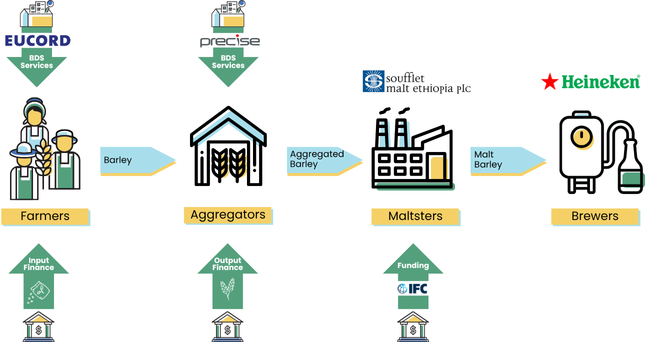En seulement dix ans, la chaîne de valeur de l'orge éthiopienne a connu une transformation remarquable, passant d'une dépendance aux importations à un statut d'exportateur net. Cette réussite, documentée dans la dernière étude de cas « Learning into Action » de l'AMEA, démontre l'efficacité d'investissements coordonnés dans les installations de transformation, le renforcement des capacités des agrégateurs et des services complets de développement des entreprises (BDS).
La phase I du projet de services de conseil IFC-Soufflet ET illustre parfaitement la manière dont les partenariats stratégiques peuvent impulser un changement systémique. Cofinancé par l'IFC et le GAFSP avec un investissement de 14,2 millions de livres sterling en services de conseil, le projet a soutenu l'investissement de 14,2 millions de livres sterling dans la malterie de Soufflet, créant ainsi une approche intégrée qui a produit des résultats exceptionnels :

Au cœur de cette transformation se trouvait le Programme de leadership en agroalimentaire (ALP), qui a fourni un service complet de développement des affaires à 100 PME agricoles, dont des agrégateurs, des coopératives et des agriculteurs modèles. Son modèle de prestation mixte, combinant séances en présentiel, coaching mobile et renforcement par SMS, s'est avéré très efficace pour renforcer les capacités des agrégateurs.
Les chiffres racontent une histoire convaincante : Pour chaque $1 investi dans le soutien BDS, les agrégateurs ont généré un chiffre d'affaires supplémentaire de $183. Calculé par rapport au coût total du package intégré (incluant le soutien agronomique et le financement des intrants), le rendement est resté impressionnant, avec un chiffre d'affaires de $27 par $1 investi.
1. La rentabilité doit être calculée en utilisant le coût de l'ensemble intégré complet
2. Une approche robuste de segmentation et d'adaptation des BDS dans la phase II devrait être développée
3. Partage des coûts pour créer une culture de paiement des services ALP
4. Investir dans des approches BDS flexibles et résilientes
5. Améliorer la collecte de données pour suivre les améliorations agronomiques
6. Améliorer la vitesse de prise de décision coopérative
7. Développer les services de paiement électronique à mesure que la couverture mobile s'améliore
8. Élaboration d’une stratégie pour l’amélioration de l’égalité des sexes
9. Évaluer le compromis entre efficacité et impact
10. Effort conscient pour diffuser l'apprentissage afin d'inspirer d'autres malteurs
Alors que la phase II du projet débute avec son expansion vers de nouvelles zones et un modèle de prestation plus efficace, les enseignements tirés offrent des perspectives précieuses aux malteurs, aux agrégateurs et aux acteurs du développement en Afrique et au-delà. La diffusion de ces enseignements sera essentielle pour inciter d'autres acteurs de la chaîne de valeur à adopter des approches intégrées similaires.
La transformation de la chaîne de valeur de l’orge éthiopienne démontre qu’avec la bonne combinaison d’investissement stratégique, de renforcement des capacités et de partenariats coordonnés, il est possible de créer un changement durable qui offre une réelle valeur aux agriculteurs tout en construisant des chaînes d’approvisionnement résilientes.
Pour toutes les dernières nouvelles sur notre travail et les mises à jour sur nos partenaires, inscrivez-vous à notre newsletter.
Nous utilisons des cookies sur notre site web pour vous offrir une expérience optimale en mémorisant vos préférences et vos visites répétées. En cliquant sur « Accepter tout », vous consentez à l'utilisation de tous les cookies. Vous pouvez toutefois accéder aux « Paramètres des cookies » pour exercer votre consentement.